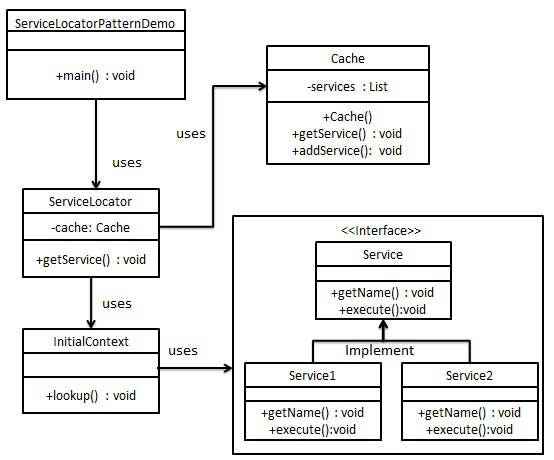服務(wù)定位器模式(Service Locator Pattern)用在我們想使用 JNDI 查詢定位各種服務(wù)的時(shí)候。考慮到為某個(gè)服務(wù)查找 JNDI 的代價(jià)很高,服務(wù)定位器模式充分利用了緩存技術(shù)。在首次請求某個(gè)服務(wù)時(shí),服務(wù)定位器在 JNDI 中查找服務(wù),并緩存該服務(wù)對象。當(dāng)再次請求相同的服務(wù)時(shí),服務(wù)定位器會在它的緩存中查找,這樣可以在很大程度上提高應(yīng)用程序的性能。以下是這種設(shè)計(jì)模式的實(shí)體。
我們將創(chuàng)建 ServiceLocator、InitialContext、Cache、Service 作為表示實(shí)體的各種對象。Service1 和 Service2 表示實(shí)體服務(wù)。
ServiceLocatorPatternDemo,我們的演示類在這里是作為一個(gè)客戶端,將使用 ServiceLocator 來演示服務(wù)定位器設(shè)計(jì)模式。

創(chuàng)建服務(wù)接口 Service。
Service.java
public interface Service {
public String getName();
public void execute();
}
創(chuàng)建實(shí)體服務(wù)。
Service1.java
public class Service1 implements Service {
public void execute(){
System.out.println("Executing Service1");
}
@Override
public String getName() {
return "Service1";
}
}
Service2.java
public class Service2 implements Service {
public void execute(){
System.out.println("Executing Service2");
}
@Override
public String getName() {
return "Service2";
}
}
為 JNDI 查詢創(chuàng)建 InitialContext。
InitialContext.java
public class InitialContext {
public Object lookup(String jndiName){
if(jndiName.equalsIgnoreCase("SERVICE1")){
System.out.println("Looking up and creating a new Service1 object");
return new Service1();
}else if (jndiName.equalsIgnoreCase("SERVICE2")){
System.out.println("Looking up and creating a new Service2 object");
return new Service2();
}
return null;
}
}
創(chuàng)建緩存 Cache。
Cache.java
import java.util.ArrayList;
import java.util.List;
public class Cache {
private List<Service> services;
public Cache(){
services = new ArrayList<Service>();
}
public Service getService(String serviceName){
for (Service service : services) {
if(service.getName().equalsIgnoreCase(serviceName)){
System.out.println("Returning cached "+serviceName+" object");
return service;
}
}
return null;
}
public void addService(Service newService){
boolean exists = false;
for (Service service : services) {
if(service.getName().equalsIgnoreCase(newService.getName())){
exists = true;
}
}
if(!exists){
services.add(newService);
}
}
}
創(chuàng)建服務(wù)定位器。
ServiceLocator.java
public class ServiceLocator {
private static Cache cache;
static {
cache = new Cache();
}
public static Service getService(String jndiName){
Service service = cache.getService(jndiName);
if(service != null){
return service;
}
InitialContext context = new InitialContext();
Service service1 = (Service)context.lookup(jndiName);
cache.addService(service1);
return service1;
}
}
使用 ServiceLocator 來演示服務(wù)定位器設(shè)計(jì)模式。
ServiceLocatorPatternDemo.java
public class ServiceLocatorPatternDemo {
public static void main(String[] args) {
Service service = ServiceLocator.getService("Service1");
service.execute();
service = ServiceLocator.getService("Service2");
service.execute();
service = ServiceLocator.getService("Service1");
service.execute();
service = ServiceLocator.getService("Service2");
service.execute();
}
}
驗(yàn)證輸出。
Looking up and creating a new Service1 object Executing Service1 Looking up and creating a new Service2 object Executing Service2 Returning cached Service1 object Executing Service1 Returning cached Service2 object Executing Service2